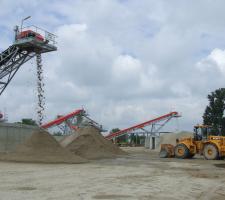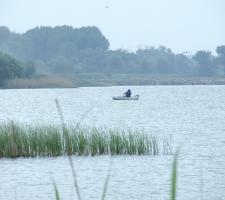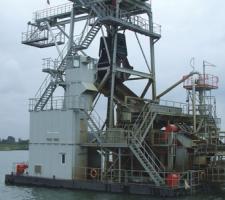
Investment at Holcim's Chepintsi Quarry in Bulgaria is not only increasing production, it is also adding new products to the offering. Claire Symes reports
Countries that have recently joined the
The sand and gravel quarry has been operating for 40 years and some of the equipment used until recently dated back to 1970s, including the two dredgers. The screening plant at the site was built during the communist era and was supposedly a 1000tonnes per hour plant but generally achieved around 300tonnnes per hour.
"In 1978 the quarry started using equipment from West Germany with a Mohr dredger and the plant was built by Bulgarian and Serbian engineers," said Holcim Aggregates production manager Ivan Slavov, who has worked at the quarry since 1985.
"The site managed to produce 63,000m3 in one year once and employed 120 people at the height of operations here. We used to use barges to transfer material from the dredger and although this involved double handling the operating costs were not very high." According to Slavov, the material from the quarry was in demand as it was well known to be the best material in the region for construction.
Holcim bought the quarry from
"There was a serious need for investment at Chipintsi," said Holcim Aggregates head of process performance improvement and capex management Mathieu Provost. "The concession here runs for another 30 years, which combined with the quarry's position close to Sofia with its high demand for infrastructure investment means that the quarry has good prospects."
Investment boost
The investment at the quarry has boosted production and the site now has capacity to produce up to 1million tonnes per year whereas before it was producing around a third of that.
The sand and gravels at Chepintsi are extracted from below water level using a dredger. "The water table here is too high to be able to pump the water and excavations extend to up to 40m below ground level," explained Provost.
The site has a new clamshell dredger, which was specified in order to be able to cut through the thick clay that is located across the site at 20 to 22m below ground level and overlies the high quality sand and gravel deposits.
Material is pre-treated on the dredger before it is transported to the fixed screening and washing plant via first a floating conveyor, and then a 1km long land conveyor. The 550tonne per hour capacity dredger and conveyors up to the stacker were supplied by Germany-based Fiebig.
The new concession at the site developed by Holcim will see the size of the lake doubled from the current 200m width to just over 400m.
The new screening and washing plant was designed and installed by Ireland-based CDE last year and was commissioned in August 2009. CDE only became involved with the project two months after the initial bid requests went out and only had six weeks to bid for the work. Nonetheless, Holcim were impressed by the proposal. "The plant was sold on usage, not just production," said Holcim Bulgaria aggregates and ready mix director Thomas Guillot. "There was also good consideration made for health and safety, ease of access and maximum utilisation. They had a modern approach to business that also appealed to us." Provost explained the challenge at Chipintsi, "The clay here is very plastic so we needed a plant that could effectively treat that and we also wanted to introduce a new fine sand product into the Sofia market to target the mortar and ceramics glue industries. To achieve this we needed a plant that could cope with a high level of fines - over 80 to 90% fall into the 0-2mm size." According to Provost, CDE's solution fitted well with the aims and discussions started in 2008.
The plant was designed to be compact and avoid large sand classifying tanks as there were some issues with ground stability at Chepintsi. "The modular design also works well with local planning constraints, "said Provost. "CDE had worked with
"Holcim generally plans capex projects together with its experts from headquarters in Zurich, Switzerland supporting the local project team. This helps to ensure a good transfer of knowledge," he said. "However, the planning system here is challenging and work needs to be managed locally." Guillot was a major force behind the investment at Chepintsi and worked closely with the expert team to define the specification and concept for the quarry and present the business case for it.
"As part of its commitments to sustainable development, Holcim operates a concept of efficient resource use and at Chepintsi there is 2 to 2.5million tonnes of material still in the current extraction area," said Guillot. "We have to extract this although it is highly contaminated by poorly managed extraction and dumping and mixing of the overburden and rejected clay - this is a real processing challenge."
Screening and washing
The new CDE plant features a main 6000tonne stock pile with four extractors placed underneath which feed onto two screens - one conventional and the other split into two to separate the fines, gravel and oversize material.
The 4 to 45mm gravel is fed into a hopper for the Atrofeed which applies attrition to remove clay material, followed by two Rotomax log washers to ensure the gravel is free from clay contamination. The product is then rinsed and dewatered before being dry screened into 4 to 22mm and 22 to 45mm products.
This material is mainly sold into the local concrete market and customers come to the quarry to collect their own products.
The more valuable product from Chepintsi is the sand. Concrete sand generally reaches BGN10 to 11 (€E5 to 6) on the Sofia market but the fine sand reaches a much higher price.
"We wanted to collect the fines and concrete sand sized material from the plant, so there is a network of pumps, sumps and cyclones built into the CDE plant to collect the in specification sand," explained Provost. "Nonetheless, there is some concern that the formation may change as extraction progresses into the new reserves so the plant also had to be designed to be flexible to cope with that." The system separates the 0 to 4mm sand for concrete and the 0 to 400?m sand for the ceramic adhesive market.
"The fine sand is a completely new product and new market," said Provost. "Saint Gobain has built a new factory close to the quarry and previously they had to dry screen and bake material before they could use it but the fine sand we are producing here means that they can avoid that process, improving quality and costs."
Staff training
The quarry currently operates just one eight hour shift due to the impact of the recession in Bulgaria but as demand increases, the quarry has the possibility of adding another shift to the operation. The dredger operates a 12 hour shift at present. "There are a lot of illegal operations which undercut our prices and have impacted on our business during the downturn," said Provost.
There are just 15 employees at the site today but before the recession here were around 45. "It is not just due to the lower demand, we are also trying to be more efficient," said Provost.
Environment improvement
Chipintsi Quarry has a good relationship with its residential neighbours and Holcim plans to improve the look of the site later this summer with new landscaping and planting of trees around the processing area. "We are lucky in that the dredging process and use of conveyors at Chepintsi makes the operation very quiet," said Provost.
The quarry will eventually be recultivated, probably as a fishing lake, although the locals already fish there. "Bulgarians don't tend to bother too much with the law - Holcim doesn't technically own the land so the people feel that the government owns it and they should have access," said Provost. "That is why we have taken steps to more clearly mark the boundary. We can tolerate fisherman on the banks of the lake but the boats are at more risk.
Holcim is also working to clean up and remove rubbish dumped around the site by the local community.The new plant is fully automated using a system supplied by a local Bulgarian company SAT which has worked closely with Holcim in the past. "CDE does offer its own automation systems but we decided to use the local company so that training could be delivered in the local language," he said. "Nonetheless, CDE has worked closely with us on machine maintenance and usage with training and monitoring.
"Use of the new equipment has been a step change for the local workforce - previously machines were run until they broke so we have had to change the mentality to understand the concept of preventative maintenance. We have also tried to get them to take ownership of the project but as a result of the previous regime here in Bulgaria, people are not used to being asked to take responsibility.
"This is still an issue when it comes to health and safety but this has improved significantly. We have our own health and safety coordinator in the area who visits the site to check and give training on a regular basis. Holcim applies its worldwide standards to its site despite the fact that they are higher than the local standards. The approach to health and safety here at Chepintsi is now more systematic." Slavov added, "The situation has changed with Holcim investing here - it is a totally new plant and with it comes new behaviour and training needs.
"In 2008 a decision was taken to change to a new plant but it has been a difficult challenge for the employees," he said. "The employees have no special education in the new technology.
"The new installation has been very interesting - the first reaction of the people was that it was not possible. But slowly we changed their thinking by explaining the concept - they just needed time to change.
"We chose the best workers to stay although when it comes to activities like cleaning, or housekeeping we still need to push the employees to do the work. There is a culture in Bulgaria of taking no responsibility so it is a challenge on site.
"We have been successful with safety - the staff are now wearing equipment and making suggestions. They now have the incentive to improve although it has taken time to shift from reaction to preventative maintenance.
"We have used increased salaries to reward improvement as well as social benefits." Guillot added, "We sent some of the staff on leadership skills courses. The aim was to help them build teams once back in the quarry."
Market forces "Bulgaria's construction market is one of the most depressed in Europe," said Guillot. "Last year demand was 50% down on 2008 levels and in 2010 we expect it to be another 25% down on volume. Prices have also been affected though.
"Gravel from Chepintsi currently fetches between e3 and e4 per tonne and sand e5 to e6 per tonne. The new fine sand product reaches a higher value - we have an agreement with Saint Gobain over price and our product matches its needs." The plant at Chepintsi has a 350tonne per hour capacity with around 80% of the production falling into the sand grades. It is expected that the quarry will produce 35,000tonnes of fine sand, 800,000tonnes of sand and 150-200,000tonnes of gravel this year.
In reality market demand is much lower but Guillot is confident that demand will return in the next two to three years. "The depression hit Bulgaria six months later than elsewhere, so the recovery is likely to be later too," he said.
EU funds were frozen but are now available again following resolution of local funding difficulties. "The previous government signed deals without finance in place," he said. "It is being sorted out now but it has made the market very challenging."

















